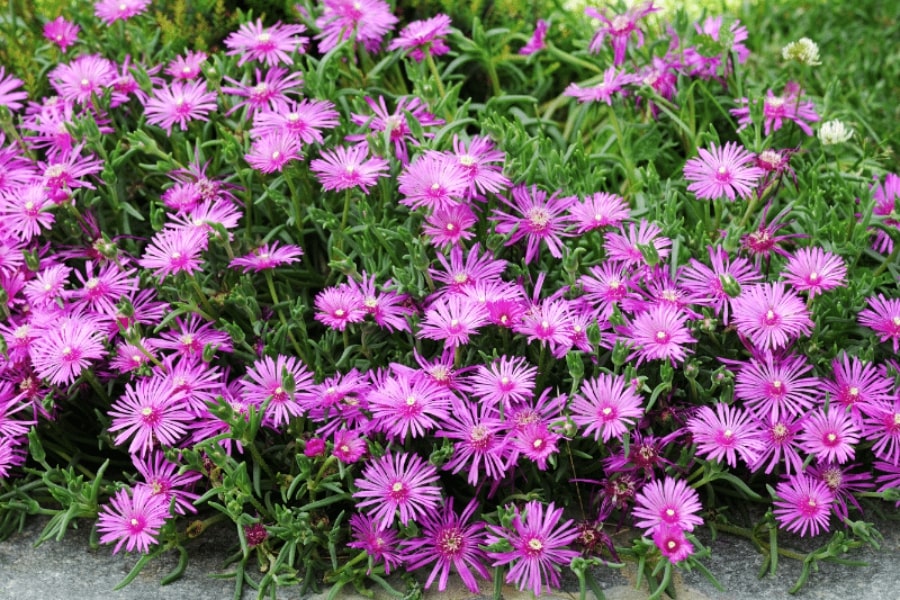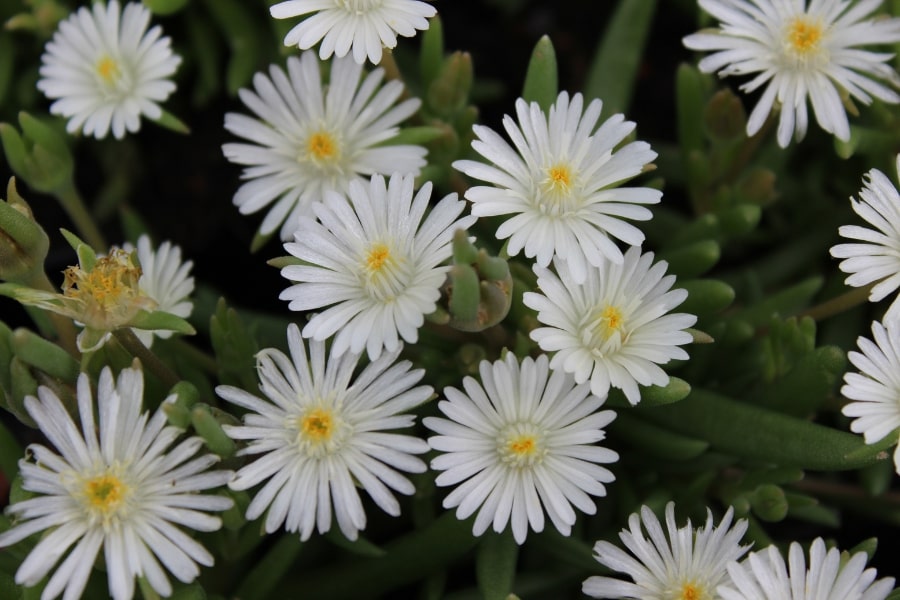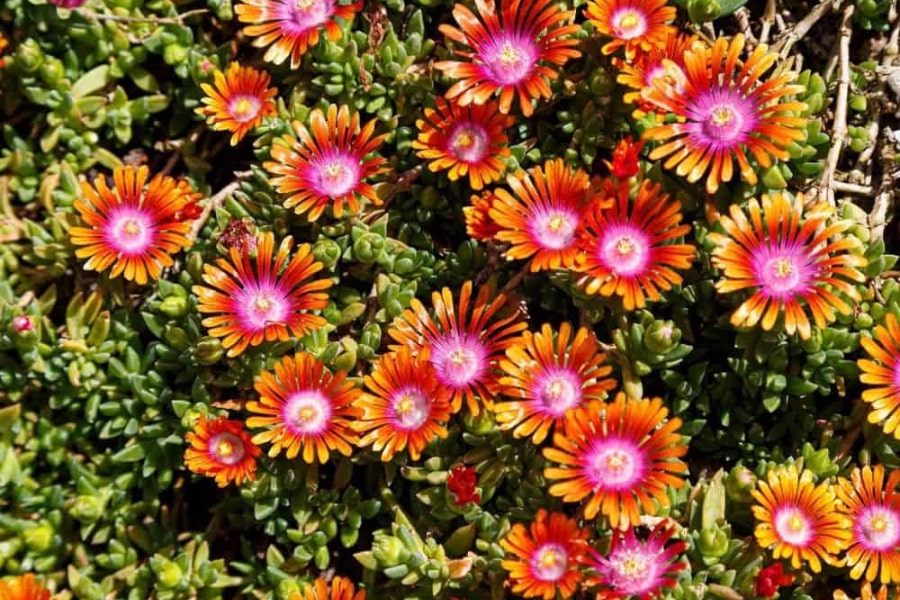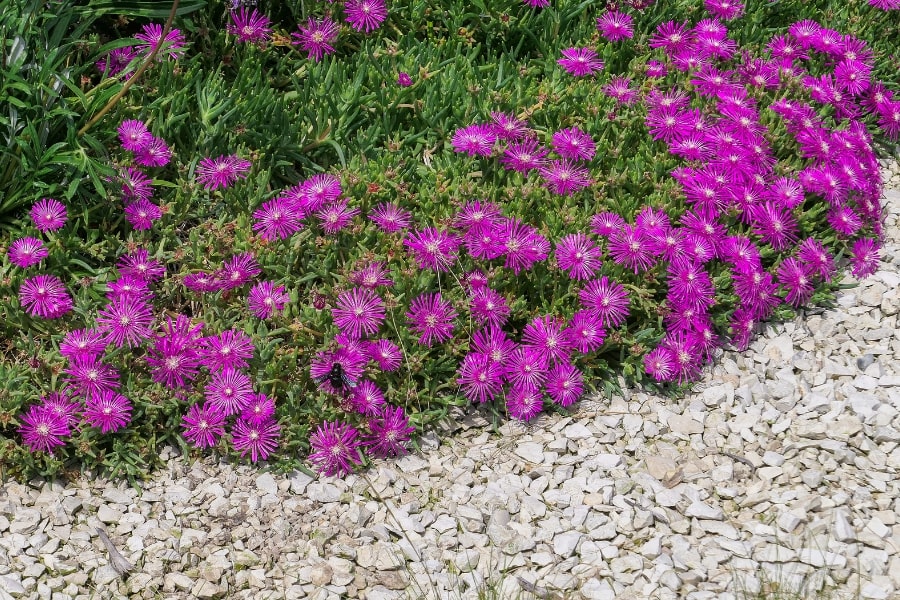Delosperma, commonly known as Ice Plant, is a genus of succulent perennial plants that are native to southern Africa. These plants are known for their vibrant, daisy-like flowers. Delosperma is best used in rock gardens, ground covers, and drought-tolerant landscapes. Their fleshy, water-storing leaves help them thrive in dry conditions, making them an excellent choice for xeriscaping and erosion control on slopes. Blooming from late Spring through Fall, Ice Plants produce dazzling carpet of color in shades of pink, purple, red, orange, yellow, and white, with numerous multi-color hues.

Our Selection of Delosperma
At Martin Garden Center, we are growing 9 varieties of Delosperma this year. We also receive Delosperma from our regional vendors, with 2-3 bloom colors usually available in our Perennial section. Common varieties that we receive from our vendors include Desert Topaz and the Wheels of Wonder Series.
We are growing the following varieties in 2025:
- Delmara Fuchsia
- Delmara Orange
- Delmara Pink
- Delmara Red
- Delmara Yellow
- Ocean Sunset Orange Glow
- Ocean Sunset Violet
- Fire Spinner
- Granita Raspberry
Growing and Caring For Delosperma
- Sunlight: Delosperma thrives in full sunlight, making it ideal for sunny and hot locations. It appreciates at least 6 to 8 hours of direct sunlight per day. This plant is designed for intense heat.
- Soil: This plant needs well-draining soil. Delosperma is highly susceptible to root rot if left in waterlogged conditions. Sandy or gravelly soils with good drainage are ideal for Delosperma. If your soil is heavy or compacted, amending it with coarse sand or gravel can improve drainage. Adding organic matter can enhance the soil structure and fertility.
- Watering: Delosperma is well-suited for xeriscaping and is known for its drought tolerance. Once established, it requires minimal watering. Overwatering is a common issue that can lead to root rot, so allow the soil to dry out between watering sessions. During periods of extreme drought, providing occasional deep watering can benefit the plant.
- Temperature: Hardy in USDA zones 5-10, Delosperma is adaptable to various temperatures but prefers warm climates. It can withstand mild frost but may suffer damage in severe winter conditions. In colder regions, ensuring well-drained soil and using mulch can help protect the plant’s roots during winter. Delosperma can bloom throughout the year in warmer climates, adding a burst of color to the landscape.
- Fertilization: Delosperma is not a particularly heavy feeder, and excessive fertilization can lead to leggy growth. A balanced, low-nitrogen fertilizer in spring or early summer is usually sufficient. Avoid over-fertilizing, as this can result in lush foliage at the expense of prolific flowering.
- Pruning: Pruning is minimal, as the plant has a low, spreading growth habit. There is no need to deadhead this plant as spent flowers will self-clean. Trimming any overly vigorous or sprawling stems can help shape the plant and prevent it from becoming too unruly.
- Pests and Diseases: Delosperma is relatively resistant to pests and diseases, contributing to its reputation as a low-maintenance plant. However, like any plant, it may encounter issues such as aphids or mealybugs. Regular plant inspection for signs of pests and prompt intervention, if necessary, can prevent infestations.

Leaves and Flowers
The leaves of Ice Plant are typically fleshy, cylindrical, and triangular, giving them a distinctive appearance. The succulent nature of the leaves is an adaptation to arid conditions, allowing the plant to store water efficiently. The leaves are often arranged in opposite pairs along the stems, creating a dense, ground-hugging mat. Their vibrant green hue contributes to the plant’s overall freshness, and some varieties may exhibit a touch of reddish or purplish tint at the leaf tips, especially during periods of intense sunlight or cooler temperatures.
The flowers of Delosperma are a true highlight, creating a stunning display of color that brightens gardens and landscapes. Appearing in profusion, the daisy-like flowers come in a wide array of vibrant hues, including shades of pink, purple, orange, yellow, and white. The petals are often arranged in a star-like pattern, surrounding a central disk that can be a contrasting color. The flowering season typically spans from late spring through summer, and some varieties may continue to bloom sporadically into the fall.

Uses in the Garden
Delosperma, commonly known as Ice Plant, is a versatile and valuable addition to the garden, offering various uses that contribute to its popularity among gardeners. One of its primary uses is as a ground cover. Delosperma’s low, spreading growth habit forms a dense mat of succulent foliage, effectively covering bare soil and suppressing weeds. This makes it an excellent choice for sunny areas with well-draining soil, such as slopes, rock gardens, or areas with challenging growing conditions.
In addition to its ground-covering qualities, Delosperma is frequently employed in rock and succulent gardens. The succulent nature of its leaves allows it to thrive in arid conditions, making it well-suited for rock gardens where water retention is crucial. Planted among boulders or nestled in gravelly soil, Delosperma adds texture, color, and a touch of whimsy to these specialized garden spaces.
Delosperma can also be used in container gardens and hanging baskets. Its trailing growth habit spills over the edges of containers, creating cascades of colorful flowers and succulent foliage. This use of Delosperma allows gardeners to enjoy its beauty on patios, balconies, or other confined spaces. The low maintenance requirements of Delosperma make it an appealing option for container gardening, as it thrives with minimal care while providing a visually striking and adaptable element to outdoor living spaces.

Frequently Asked Questions
Is Delosperma a Perennial?
Yes, Delosperma is a perennial. Delosperma is known for its hardiness and ability to endure various environmental conditions, making it a reliable and long-lasting addition to gardens.
Is Delosperma Toxic to Cats and Dogs?
Delosperma is not listed as toxic to cats and dogs. However, individual pets may react differently to plants. If you have concerns about your pet’s interactions with Delosperma or any other plant, it’s best to consult a veterinarian for personalized advice.
Is Ice Plant Deer Resistant?
Ice plant, also known as Delosperma, is generally considered deer resistant due to its succulent foliage and low palatability to browsing animals. The thick, fleshy leaves of ice plants are not typically preferred by deer, making them less likely to be consumed than more tender vegetation. However, it’s always wise to monitor your garden and employ additional protective measures to deter hungry visitors.
